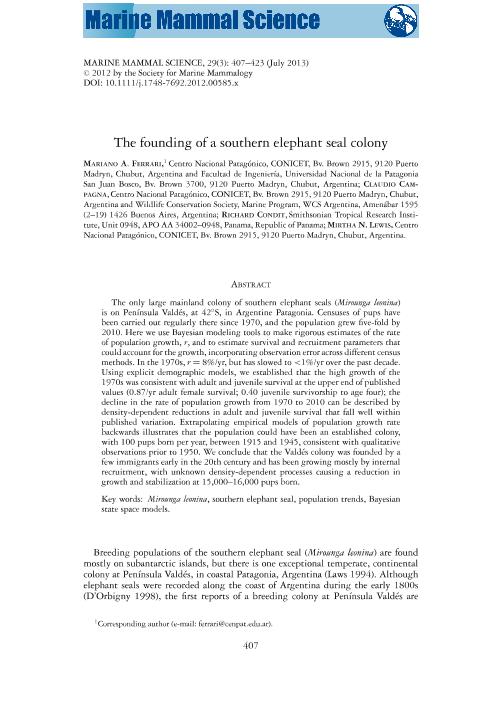Mostrar el registro sencillo del ítem
dc.contributor.author
Ferrari, Mariano Andrés

dc.contributor.author
Campagna, Claudio

dc.contributor.author
Condit, Richard
dc.contributor.author
Lewis, Mirtha Noemi

dc.date.available
2016-04-25T20:46:50Z
dc.date.issued
2013-07
dc.identifier.citation
Ferrari, Mariano Andrés; Campagna, Claudio; Condit, Richard; Lewis, Mirtha Noemi; The founding of a southern elephant seal colony; Wiley; Marine Mammal Science; 29; 3; 7-2013; 407-423
dc.identifier.issn
0824-0469
dc.identifier.uri
http://hdl.handle.net/11336/5377
dc.description.abstract
The only large mainland colony of southern elephant seals (Mirounga leonina) is on Peninsula Valdes, at 42ºS, in Argentine Patagonia. Censuses of pups have been carried out regularly there since 1970, and the population grew five-fold by 2010. Here we use Bayesian modeling tools to make rigorous estimates of the rate of population growth, r, and to estimate survival and recruitment parameters that could account for the growth, incorporating observation error across different census methods. In the 1970s, r = 8%/yr, but has slowed to < 1%/yr over the past decade. Using explicit demographic models, we established that the high growth of the 1970s was consistent with adult and juvenile survival at the upper end of published values (0.87/yr adult female survival; 0.40 juvenile survivorship to age four); the decline in the rate of population growth from 1970 to 2010 can be described by density-dependent reductions in adult and juvenile survival that fall well within published variation. Extrapolating empirical models of population growth rate backwards illustrates that the population could have been an established colony, with 100 pups born per year, between 1915 and 1945, consistent with qualitative observations prior to 1950. We conclude that the Vald´es colony was founded by a few immigrants early in the 20th century and has been growing mostly by internal recruitment, with unknown density-dependent processes causing a reduction in growth and stabilization at 15,000?16,000 pups born.
dc.format
application/pdf
dc.language.iso
eng
dc.publisher
Wiley

dc.rights
info:eu-repo/semantics/openAccess
dc.rights.uri
https://creativecommons.org/licenses/by-nc-sa/2.5/ar/
dc.subject
Mirounga Leonina
dc.subject
Southern Elephant Seal
dc.subject
Population Trends
dc.subject
Bayesian State Space Models
dc.subject.classification
Matemática Aplicada

dc.subject.classification
Matemáticas

dc.subject.classification
CIENCIAS NATURALES Y EXACTAS

dc.subject.classification
Ecología

dc.subject.classification
Ciencias Biológicas

dc.subject.classification
CIENCIAS NATURALES Y EXACTAS

dc.title
The founding of a southern elephant seal colony
dc.type
info:eu-repo/semantics/article
dc.type
info:ar-repo/semantics/artículo
dc.type
info:eu-repo/semantics/publishedVersion
dc.date.updated
2016-05-06 15:52:43.262787-03
dc.journal.volume
29
dc.journal.number
3
dc.journal.pagination
407-423
dc.journal.pais
Estados Unidos

dc.journal.ciudad
Hoboken
dc.description.fil
Fil: Ferrari, Mariano Andrés. Consejo Nacional de Investigaciones Científicas y Técnicas. Centro Nacional Patagónico; Argentina. Universidad Nacional de la Patagonia "San Juan Bosco"; Argentina
dc.description.fil
Fil: Campagna, Claudio. Consejo Nacional de Investigaciones Científicas y Técnicas. Centro Nacional Patagónico; Argentina. Wildlife Conservation Society; Estados Unidos
dc.description.fil
Fil: Condit, Richard. Smithsonian Tropical Research Institute; Panamá
dc.description.fil
Fil: Lewis, Mirtha Noemi. Consejo Nacional de Investigaciones Científicas y Técnicas. Centro Nacional Patagónico; Argentina
dc.journal.title
Marine Mammal Science

dc.relation.alternativeid
info:eu-repo/semantics/altIdentifier/url/http://onlinelibrary.wiley.com/doi/10.1111/j.1748-7692.2012.00585.x/abstract
dc.relation.alternativeid
info:eu-repo/semantics/altIdentifier/doi/http://dx.doi.org/10.1111/j.1748-7692.2012.00585.x
dc.relation.alternativeid
info:eu-repo/semantics/altIdentifier/doi/10.1111/j.1748-7692.2012.00585.x
Archivos asociados
